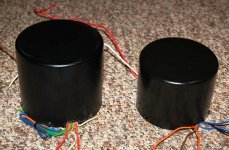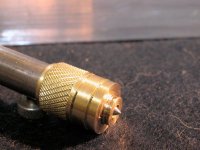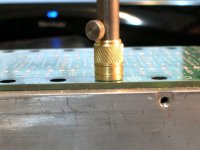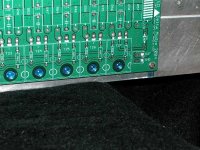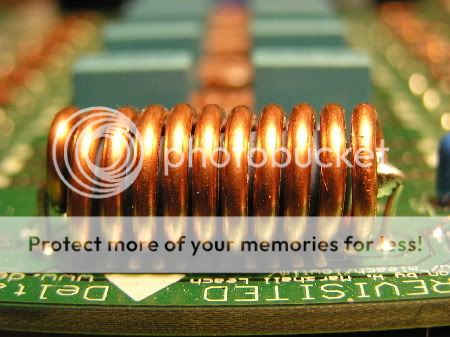AndrewT said:
For 8ohm speakers C must be >=+-20mF/ch.
For 4ohm speakers C must be >=+-40mF/ch.
For very high power amplifiers, a second rule becomes applicable.
>=2mF/Apk of output current, to reduce cap ripple to an (arguably) acceptable level.
Hi Andrew,
Please confirm, is your term mF equal to millifarad, or microfarad?
I read it as micro, but the value seems to be much to small.
Thanks,
Rob
Hi,
For those in doubt about SI units
m = milli (10^-3)
µ = micro (10^-6)
s = second (note that s is lower case)
S = Siemens (Ohm^-1) (Conductance S is upper case)
S is actually a derived unit [Amp/Volt]
ms = milli second
mS = milli Siemens!
Find more here: http://en.wikipedia.org/wiki/SI_units
\\\Jens
For those in doubt about SI units
m = milli (10^-3)
µ = micro (10^-6)
s = second (note that s is lower case)
S = Siemens (Ohm^-1) (Conductance S is upper case)
S is actually a derived unit [Amp/Volt]
ms = milli second
mS = milli Siemens!
Find more here: http://en.wikipedia.org/wiki/SI_units
\\\Jens
AndrewT said:that 1.5V across the resistor will affect the accuracy of the testing.
if you put a 19.9V Zener in it will leave 21.5-19.9=1.6V across the 1k0, passing 1.6mA through the Zener, ~32mW (<10% 0f 400mW rating).
now put in a 20.1V Zener. It will pass just 1.4mA. this is even less than the 32mW of the previous and will result in a voltage measurement that is not comparable to the first test.
You need a more consistent current source. Either a higher regulated voltage or a CCS.
I recommend that Zeners dissipate >=10% of rated power for consistent voltage regulation.
But the final test is in the powered amp, that is the one that matters.
Not a suprise, Andrew was correct on this. My first front-end test revealed a voltage mis-match (@ 2/10v). I will have to rematch all my zeners with a proper test
Which transformer
I have two pairs of transformers from which to choose:
Type#1 (from 120W stereo receivers) has a single set of center-tapped secondaries(45-0-45vac), weighs 13.5 lbs and I don' t know the VA rating;
Type#2 (from a 100w dual mono amps) has TWO sets of center-tapped secondaries(40-0-40 vac @ 1.6Aea), and weighs a tad over 9 lbs .
I plan to use the BrianGT power supply board, with between 22,000 and 33,000uf per rail.
For use here in assembling stereo amps, which would be more advantageous?
How about for assembling a pair of mono amps?
Here's a photo of each:
I have two pairs of transformers from which to choose:
Type#1 (from 120W stereo receivers) has a single set of center-tapped secondaries(45-0-45vac), weighs 13.5 lbs and I don' t know the VA rating;
Type#2 (from a 100w dual mono amps) has TWO sets of center-tapped secondaries(40-0-40 vac @ 1.6Aea), and weighs a tad over 9 lbs .
I plan to use the BrianGT power supply board, with between 22,000 and 33,000uf per rail.
For use here in assembling stereo amps, which would be more advantageous?
How about for assembling a pair of mono amps?
Here's a photo of each:
Attachments
Both stated VA ratings seem low for a stereo amp. However, depending on how much of the weight is potting, they may be suitable.
Avel's un-potted 650 VA transformers weigh in at 10.8 pounds. The larger one could be capable of similar output. The problem is the voltage rating demands a higher VA rating if you want to extract the maximum power from your amps.
In normal home use (is that becoming my trademark?) you can use either, especially if your speakers are near 8 ohms nominal. No, you won't get as much power as the amp is capable of into low impedance loads. However, toroidal transformers can handle significant intermittent overloads. I'd lean towards the smaller one for its separate windings and the fact that you can use 63V caps.
If you want to get higher power into lower impedance loads go for at least 600 VA. You know where I'd look for inexpensive transformers...
Avel's un-potted 650 VA transformers weigh in at 10.8 pounds. The larger one could be capable of similar output. The problem is the voltage rating demands a higher VA rating if you want to extract the maximum power from your amps.
In normal home use (is that becoming my trademark?) you can use either, especially if your speakers are near 8 ohms nominal. No, you won't get as much power as the amp is capable of into low impedance loads. However, toroidal transformers can handle significant intermittent overloads. I'd lean towards the smaller one for its separate windings and the fact that you can use 63V caps.
If you want to get higher power into lower impedance loads go for at least 600 VA. You know where I'd look for inexpensive transformers...
I got 170W into 8r0 from a 0-40, 0-40Vac transformer using Jens' 3pair board. It was over 300W into 4r0 but SOAR is well used at this combination of voltage and low impedance.
If you plan to never use 4ohm, nor 6ohm, nor 4 to 8ohm speakers then the higher voltage transformer can be used for 8ohm speakers and above.
But, the 45Vac will require >=75Vdc capacitors.
If you plan to never use 4ohm, nor 6ohm, nor 4 to 8ohm speakers then the higher voltage transformer can be used for 8ohm speakers and above.
But, the 45Vac will require >=75Vdc capacitors.
Chas, With the interest you are applying to this project I think it might be advantageous to spring for a toroid from Bob's favorite hobby store, Apex Jr., and then be assured you will achieve the results you are after.
Unless you know the history behind your present trannys it might not turn out pleasant. Decide what results you wish to achieve and place the appropriate item in to get there. You could also include some power supply caps in with the purchase and save on overall shipping charges. Apex has some good cap deals. Antek is another good choice for quality trannies. There service is great. I think the transformer is one of the most important choices.
Tad
Unless you know the history behind your present trannys it might not turn out pleasant. Decide what results you wish to achieve and place the appropriate item in to get there. You could also include some power supply caps in with the purchase and save on overall shipping charges. Apex has some good cap deals. Antek is another good choice for quality trannies. There service is great. I think the transformer is one of the most important choices.
Tad
got some nice big electolytics from Steve @ Apexjr. Send him an email with what you're looking for, he'll keep an eye on hooking you up.
A while back I looked at Apex Jr. and he was offering Hitachi 22,000/100v caps but they're no longer listed.
Anyone know where I can get some 80v-100v caps >15,000uf?
Joe
I picked up six of them. They appear to be knock-off's, I have yet to test quality, but the price was favorable.
A while back I looked at Apex Jr. and he was offering Hitachi 22,000/100v caps
Mouser has them - they only stock snap in to 8,600 uf, larger expect a 21 week lead time. In screw terminal you can get 30 pieces of 24,000 uF 100V cap for a mere $68.36 --- EACH 



I have SO much stuff that used to be Steve's because you never know when you are going to see a deal like he offers again. I got the last pair of 68,000 uf 100V caps at $25 each after he took them off the page. Give him a call. He still had lots of 6800 uF 80V snap ins a month ago.
I got the last pair of 68,000 uf 100V caps at $25 each after he took them off the page. Give him a call. He still had lots of 6800 uF 80V snap ins a month ago.




I have SO much stuff that used to be Steve's because you never know when you are going to see a deal like he offers again.
 I got the last pair of 68,000 uf 100V caps at $25 each after he took them off the page. Give him a call. He still had lots of 6800 uF 80V snap ins a month ago.
I got the last pair of 68,000 uf 100V caps at $25 each after he took them off the page. Give him a call. He still had lots of 6800 uF 80V snap ins a month ago.Re: Which transformer
This translates into 130VA per secondary. If you parallel 2 secondaries, this is equivalent to a 260VA 40-0-40 which should be good for one channel, i.e. one mono block. This is pretty much half of the Avel 530VA 40-0-40 that I plan to use for a stereo.clm811 said:
Type#2 (from a 100w dual mono amps) has TWO sets of center-tapped secondaries(40-0-40 vac @ 1.6Aea), and weighs a tad over 9 lbs .
If you are about to drill and tap the heat sinks, putting thoses hole dead on is no easy task. I made a small fixture out of brass. Use a 1/8th drill rod in a hole through the brass. Grind a point on the drill rod. Machine a step on the brass so it will just fit in the large holes tightly on your pc board. Once you have bolted your pc board to your heat sink, use the brass piece and the pointed drill rod to center punch all the rest of the holes. If the drill rod is centered in the hole in the brass, then all the center punch marks will be dead-on.
Attachments
Heat Sinks
more photos
This should also work with the stand-offs in position if you already populated your board. You will lose accuracy as you move away from the Heat Sink but it should work with the stand-offs in place if the board is already populated.
more photos
This should also work with the stand-offs in position if you already populated your board. You will lose accuracy as you move away from the Heat Sink but it should work with the stand-offs in place if the board is already populated.
Attachments
Nice going my friends
Thanks, Fred. That is reassuring, since I was beginning to feel a little buyers remorse.
NICE WORK BRUTEPUPPY!!!!
Time and again I'm amazed by your skills and ingenuity! I'm glad those new boards are working out for you. Once the doc sez I can get back on my feet, I'd like to bring my precious heatsinks over to mark them with your cool device- hope I don't Gall'em (hehe)
I consider myself lucky to have such good friends here (you too, Tad and Bob)!
I'm expecting another good DIY friend over tomorrow, just planning to hang out and listen to some music- after all that's what this is all about, right?
Everyone: PLEASE post your progress pics(no matter what stage).
-Chas
If you parallel 2 secondaries, this is equivalent to a 260VA 40-0-40 which should be good for one channel, i.e. one mono block.
Thanks, Fred. That is reassuring, since I was beginning to feel a little buyers remorse.
NICE WORK BRUTEPUPPY!!!!
Time and again I'm amazed by your skills and ingenuity! I'm glad those new boards are working out for you. Once the doc sez I can get back on my feet, I'd like to bring my precious heatsinks over to mark them with your cool device- hope I don't Gall'em (hehe)
I consider myself lucky to have such good friends here (you too, Tad and Bob)!
I'm expecting another good DIY friend over tomorrow, just planning to hang out and listen to some music- after all that's what this is all about, right?
Everyone: PLEASE post your progress pics(no matter what stage).
-Chas
BP, That is a nice little rig you built there. I use transfer punches which come in graduated diameters. You can get a whole set from Harbor Freight for about 6.00 bucks. In any case it makes for more accurate drilling using these kinds of setups. I like the nice knurled knob. How did you make that?
Bob, At 68 dollars and change each you should buy all of us a set of 16. Man where do they come off charging that much for caps PLUS shipping. Like 100.00 each for a 47000 uf 100 volt Rifa. We need more sources like Apex. At least Steve has stuff that is not stale dated like fleabay.
Has anyone found a link to a site for smelting aluminum cans to make our own heatsinks? That is another area where my money just does not stretch too far.
I found these really neat knurled brass knobs at Ace hardware plus a brass screw for my speaker terminals. It works real nice, is simple and cost effective. You can solder directly to the brass. Make an insulating ring and bushing from an old (or new) polyurethane cutting board from the dollar store. Much cheaper and stouter than high dollar Cardas speaker posts.
Tad
Bob, At 68 dollars and change each you should buy all of us a set of 16. Man where do they come off charging that much for caps PLUS shipping. Like 100.00 each for a 47000 uf 100 volt Rifa. We need more sources like Apex. At least Steve has stuff that is not stale dated like fleabay.
Has anyone found a link to a site for smelting aluminum cans to make our own heatsinks? That is another area where my money just does not stretch too far.
I found these really neat knurled brass knobs at Ace hardware plus a brass screw for my speaker terminals. It works real nice, is simple and cost effective. You can solder directly to the brass. Make an insulating ring and bushing from an old (or new) polyurethane cutting board from the dollar store. Much cheaper and stouter than high dollar Cardas speaker posts.
Tad
Tad, the whole set of transfer punches seems like the "way to go" if you cannot make your own as I did. I have a lathe and can make my own transfer punch, hence. a nice close fit every time. The knurl comes from the use of a kurling tool specifically designed for small lathes. I got it from "Little Machine Shop" on the web. It's the scissor type and does not put a lot of strain on the tool post and works really great. I highly reccomend it to any of you that may have a small lathe.
BP
BP
- Home
- Group Buys
- Jens Rasmussen Leach clone group buy
